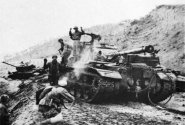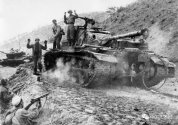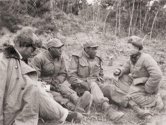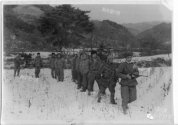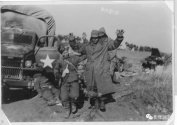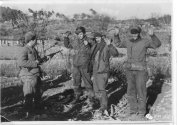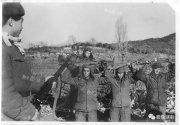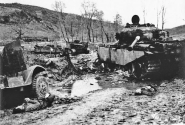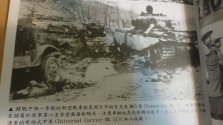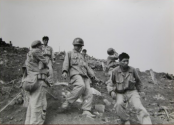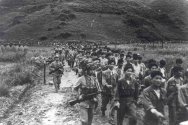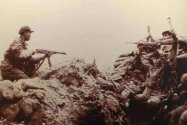You are using an out of date browser. It may not display this or other websites correctly.
You should upgrade or use an alternative browser.
You should upgrade or use an alternative browser.
Korean War 70 years later Win Lose and A draw
- Thread starter TerraN_EmpirE
- Start date
The Korean War saw one of the earliest usages of modern armoured, or ballistic, vests. Designed by the US Marine Corps, these vests contained plates of bonded fibreglass armour. Capable of stopping pistol bullets but not rifle or machine-gun bullets, the vests were intended to protect the wearer from grenade and shell fragments.
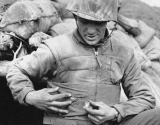
A U.S Soldier displays a piece of shrapnel that lodged in his armored vest during frontline action in Korea on March 30, 1952. The impact knocked him to the ground, but the vest, reinforced with Doriot’s “Doron,” was credited with saving him from serious injury.
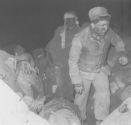
This photo is believed to have been taken on the night of November 2 , 1952 . The photo is of an American prisoner of war. At this point, he was wounded and was walking through the trenches of the Volunteer Army. (You can see several Chinese Volunteer Soldiers in the background maintaining their positions).
If you look closely at this photo, you will find that the military uniform on this U.S Serviceman is special. Indeed, he was wearing the new U.S. military nylon body armor.
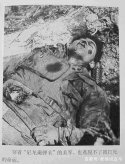
This photo shows the body of a U.S Soldier wearing body armor kiilled by the Chinese Volunteer Army. I'd really appreciate if someone could translate the text at the bottom. Thank you

A U.S Soldier displays a piece of shrapnel that lodged in his armored vest during frontline action in Korea on March 30, 1952. The impact knocked him to the ground, but the vest, reinforced with Doriot’s “Doron,” was credited with saving him from serious injury.

This photo is believed to have been taken on the night of November 2 , 1952 . The photo is of an American prisoner of war. At this point, he was wounded and was walking through the trenches of the Volunteer Army. (You can see several Chinese Volunteer Soldiers in the background maintaining their positions).
If you look closely at this photo, you will find that the military uniform on this U.S Serviceman is special. Indeed, he was wearing the new U.S. military nylon body armor.

This photo shows the body of a U.S Soldier wearing body armor kiilled by the Chinese Volunteer Army. I'd really appreciate if someone could translate the text at the bottom. Thank you
The Korean War saw one of the earliest usages of modern armoured, or ballistic, vests. Designed by the US Marine Corps, these vests contained plates of bonded fibreglass armour. Capable of stopping pistol bullets but not rifle or machine-gun bullets, the vests were intended to protect the wearer from grenade and shell fragments.
View attachment 95665
A U.S Soldier displays a piece of shrapnel that lodged in his armored vest during frontline action in Korea on March 30, 1952. The impact knocked him to the ground, but the vest, reinforced with Doriot’s “Doron,” was credited with saving him from serious injury.
View attachment 95666
This photo is believed to have been taken on the night of November 2 , 1952 . The photo is of an American prisoner of war. At this point, he was wounded and was walking through the trenches of the Volunteer Army. (You can see several Chinese Volunteer Soldiers in the background maintaining their positions).
If you look closely at this photo, you will find that the military uniform on this U.S Serviceman is special. Indeed, he was wearing the new U.S. military nylon body armor.
View attachment 95667
This photo shows the body of a U.S Soldier wearing body armor kiilled by the Chinese Volunteer Army. I'd really appreciate if someone could translate the text at the bottom. Thank you
American soldiers, wearing the "nylon bullet proof vest", still cannot escape their fate of being killed
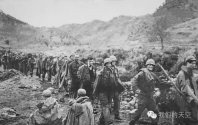
U.N POWs are escorted by Chinese Soldiers to the rear. Unknown date.
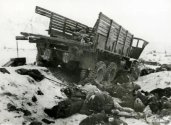
December 1950, the wrecked truck and corpses of American soldiers at the scene of the Battle of Changjin Lake. Photo by Chinese war photographer Zhang Chongxiu
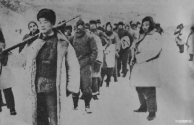
Chinese Volunteer Soldiers captured a large number of American soldiers in Gancikai in the Changjin Lake area. Photo by Zhang Chongxiu
supercat
Colonel
China/N. Korea did not have an overwhelming advantage in the number of ground troops. As I suspected, "human wave" attack is just a myth. The devastating results of such tactic had already been demonstrated in the battlefields of WWI unequivocally. What China accomplished was achieving tactical numerical advantages before attacks through superior maneuvering.
Last edited:
So bean counting is a bit complex here.Lol this is a pretty misleading way to put things.
Sure, at the outset of Chinese intervention, the UN forces in total possessed more manpower on the peninsula, but the PVA absolutely held local superiority in manpower as they intervened, which was part of why they were so successful in overrunning, encircling, or fixing the relatively piecemeal UN force at the tip of the spear. As troop numbers swelled, the PVA+KPA forces committed to the fight grew a fair bit larger than the UN's ground force. Even that 495,000 figure for UN forces isn't counting only those on the front; but includes the fairly extensive forces to the rear and not involved in the fighting.
1. UN ground forces had more tail for each tooth compared to the PVA, which was overwhelmingly light infantry. But that was mainly the result of the two sides have vastly different firepower: UN forces had a modern, industrial army with its long, heavy logistics tail. But Chinese forces only had light infantry, with no real armor or artillery, or any of that complex matrix of support units that say, your typical US formation did. So while US formations may have nominally less frontline rifle/MG strength, they far exceeded Chinese formations in overall equipment levels, fires, survivability, etc. Should we only count pure infantry vs infantry, and ignore logistics, medical, and other “support” or indirect fire personnel that enabled US units to generate far more firepower than their Chinese equivalent, even if they were in the rear and weren’t directly in combat? For example one of the major PVA shortcomings of the war was lack of the humble truck. The US of course, had no similar problem with overland logistics flow on the peninsula. Guys who drove resupply convoys (88M or what their equivalent was back then) from US controlled ports to US bases near or a medium distance from the frontline would’ve been considered rear support personnel. Critical to sustaining the fight. But since they weren’t literally infantry or in any other sort of direct ground combat arms MOS, should they be counted as part of the UN total? Total firepower superiority can overcome slight or even moderate (or large?) defficiencies in raw personnel count. During the 2003 drive to Iraq, the US/UK coalition in ground personnel were outnumbered by the Iraqis, who were weakened after a decade+ of sanctions, but managed to quickly overcome resistance.
2. But let’s say we accept that PVA forces in direct infantry units exceeded the number of UN forces in frontline rifle/MG strength, then how should categorize air force personnel and aircraft, who relentlessly razed North Korea to the ground and helped attrit PVA ground forces? Mao’s own son famously died from the intense aerial bombardment of UN forces.
3. For that matter how should we count in-theater UN naval forces, who also helped generated A2G firepower from their flat tops?
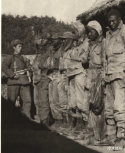
Chinese Volunteer Soldier guards African American POWs with his M3 submachine gun, Second Phase Offensive
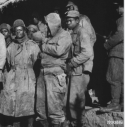
Chinese Volunteer Soldier guards African American POWs with his M3 submachine gun, Second Phase Offensive
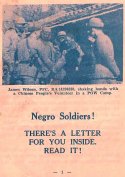
This picture shows African American serviceman, Private First Class James Wilson, shaking hands with his Chinese Communist captors. This cover is part of a pamphlet created by the KPA and PVA, Here is an excerpt of the text:
Did you ever stop to think why you should be in Korea, fighting other colored people, while lynchings, murders and insults pile up against the Negro people at home?
Since the Korean War began there have been more lynchings and killing in all parts of the country than ever before.
In the Army, less than one Negro in 70 is commissioned, while there is one white officer for approximately every seven enlisted men. In the Navy there are only two Negro officers; There are 58,571 white officers. The Marine Corps has 7,798 officers not one of whom is a Negro.
We say: No U.S. soldiers have any business in Korea for the Koreans. China for the Chinese. America for the Americans, Negro and white. Americans, black and white, unite and fight for peace.
…We didn’t come 5,000 miles across the sea to fight. We didn’t come to America with guns and bombs and we never will. Don’t risk your lives here. Ask to go home where you can fight for your own rights as a human being. Leave us in peace in our homes here.
The leaflet goes on to report lynchings and crimes against black men both in the United States and in the U.S. Army in Korea. It discusses politics in the United States and points out how few black Congressmen and Senators hold office. It reminds the black soldiers of how few black officers have been commissioned in the military.

